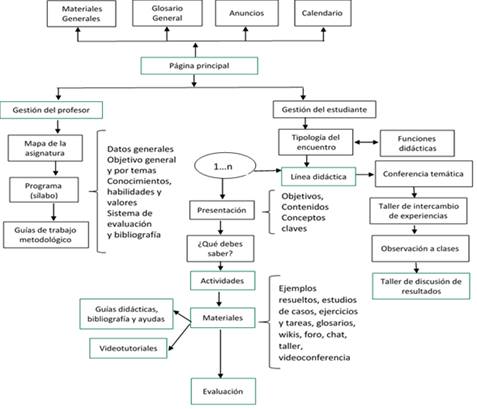Mi SciELO
Servicios Personalizados
Articulo
Indicadores
-
 Citado por SciELO
Citado por SciELO
Links relacionados
-
 Similares en
SciELO
Similares en
SciELO
Compartir
Mendive. Revista de Educación
versión On-line ISSN 1815-7696
Rev. Mendive vol.18 no.1 Pinar del Río ene.-mar. 2020 Epub 02-Mar-2020
Original article
Teacher support system from a virtual teaching-learning environment
1 Universidad Tecnológica de La Habana José Antonio Echeverría. Cuba
At present, the virtualization of training processes is a requirement for the permanent training of university teaching staff. Each day the spaces for interaction and ways of learning impose the need to use interactive platforms that make it possible to provide the necessary help to teachers, as well as to share good practices. The present work approaches the didactic conception, and implementation of a system of teaching support for university professors supported in a virtual environment of teaching-learning (Moodle) based on a bl ended learning model (b-learning), in which the activities and resources for the development of the research, the methods of document analysis, modeling and functional systemic structural method were used. The results of its implementation in practice make it possible to make decisions for the improvement and continuity of the teaching accompaniment, as well as for the solution of the didactic problems.
Key words: teaching accompaniment; virtual teaching-learning environment; b-learning
Introduction
The current era has become a scenario in which the dissemination and socialization of information and knowledge constantly bursts into the lives of most human beings. The wide variety of information and content generation indicate the need to rethink the role of educational spaces and the role of institutions in the training of professionals, particularly in the permanent formation of the golden teacher.
The permanent training of teachers is developed from various training processes, (overcoming and self-improvement, postgraduate, research, innovation and teaching work). Its diversity determines the need to incorporate different models, conceptions and methodologies that facilitate learning, with a view to the production of new knowledge and the improvement of teaching performance.
Therefore, it is necessary to continue in the search for alternatives that consider the new learning ecosystems and the integration of information and communication technologies to the training processes, in order to generate spaces for reflection and content generation in activities that teachers do.
Changes in the ways of teaching and learning from studies in the area of Neurosciences, as well as the use and integration of information and communication technologies in the teaching-learning process introduce transformations in spaces and contexts of learning, in its space-time dimension, in the interaction of the participants, as well as in the integration of multiple teaching tools and resources, which increasingly make it possible to develop self-learning processes in teachers to lead to an improvement in the permanent training (Santos, 2018, p.7).
In the Manual for the development of virtual training (Cabero and others, 2014) reference the advantages that different authors (Cabero and Gisbert, 2005; Bautista, Borges and Fores, 2006; Roig, Mengual and Rodríguez, 2013) attribute to the virtual training Among them are:
It adapts easily to the characteristics and needs of the participants; connect participants located in different geographical locations ; the rhythm of learning is marked by the students; content update is easy; It offers space-time flexibility for training, facilitates the interactivity of the teacher with their students, of the students between them and of the students with the learning objects, resources can be used in different formats: text, video clip, audio podcast simulators; Different types of synchronous and asynchronous communication tools can be used to facilitate interaction between the different participants in the training action and the training scenarios are expanded (p. 11).
These arguments reveal the importance of the educational scope of ICT in a new dynamic of the teaching- learning process.
The variety of possibilities offered by ICTs, diversified in personal learning environments [Personal Learning Environments (PLE)] (Adell and Castañeda, 2010), massive and open online courses [Massive Online Open Courses (MOOC)], Virtual Teaching-Learning Environments (EVEA), social networks and collaborative tools (blogs, wikis, forums), lead us to rethink how teachers should learn as part of their lifelong learning and how should students learn ?; What skills must be formed to achieve the necessary knowledge ?; How to design learning situations and teaching tasks that lead to developer learning? In addition, how do you evaluate learning from the different resources, tools and methodologies to be used?
In this sense, in the TPACK model (Technological Pedagogical Content Knowledge) it is recognized that teachers must have a domain of knowledge related to the content they impart, mastery of pedagogical skills and those related to the use of technological tools and their applications, conceiving that in the interaction of these three dimensions the technological-pedagogical-disciplinary knowledge is manifested (Mishra and Koehler, 2006).
Therefore, it is essential to promote training spaces and teacher support for the training and development of competencies in teachers, not only technological, but of didactic competences that enable the integration of ICT in the training processes in which they participate.
In this sense, García (2018) agrees when he argues that it is necessary "... to integrate, harmonize, complement and combine the means, courses, technologies, methodologies, activities, strategies and techniques ..., more appropriate to meet each specific need of learning, trying to find the best possible balance between such curricular variables "(p.16).
The accompanying teacher as an organizational form can provide the necessary assistance to teachers to efficiently perform their pedagogical activity. Its systematic nature makes it possible to carry out a follow-up to jointly assess the transformations or improvements of professional performance, given any difficulty that the teacher presents, curricular changes, and introduction of new content or realization of some didactic innovation.
The accompaniment system complements the preparation that the teacher receives through the improvement and the didactic work. This enables its updating, reorientation and specialization and can be group or individual depending on its purpose.
The objective of this work is to propose a system of teacher support for university professors supported in a virtual teaching-learning environment (Moodle) based on a blended teaching model, in which activities and resources are complemented.
Materials and methods
The research was carried out at the University of San Agustín de Arequipa as part of a collaboration agreement with the Reference Center for Advanced Education (CREA) of the Technological University of Havana "José Antonio Echeverría" within the framework of the curriculum reform that is carried out.
The study was based on a descriptive qualitative methodology, in which the proposal was modeled, based on the results achieved in practice, with the participation of the Advisory Commission of the Teaching vice Rectorate and the professors of the careers, in order to readjust the proposal.
For the development of the research, the documentary analysis of the normative bases was carried out University Law 30220 of the Ministerio de Educación del Perú (2014) and Modelo Educativo de la Universidad (2016). Modeling and functional structural systemic method were used for the design of the classroom teacher support system and the virtual teaching-learning environment (components and dynamic to functional). In addition, a survey was applied that made it possible to assess the results in the didactic line worked during the teaching accompaniment, which was analyzed, based on absolute and relative frequency distributions.
The implementation of the teaching support was carried out in two stages.
In the first stage (year 2017), the structure of the teacher support system, its components and fundamental relationships was determined. This was implemented in 45 of the 47 schools of the university.
In the second stage (first semester of the year 2018) the structure of the didactic design for the virtual teaching-learning environment (Moodle) was determined and its implementation on the platform of the University Directorate of Information and Communication Technologies (DUTIC).
For this, it was necessary to specify the technological availability of the institution, the institutional will to support the implementation of the support system in practice and the preparation of teachers for work from virtual training environments.
In this second stage, 34 professors participated, who were selected as facilitators, taking into account the results of the first stage and the didactic line evaluation by competences.
During the teaching support on the platform, didactic and video tutorial guides were used that made it possible to guide the activities and provide the necessary help to the teachers for the filming of their classes and subsequent editing.
At the end of the virtual teaching accompaniment, a survey was applied to the teachers to evaluate the results of the classes that were filmed and subsequently placed on the platform. These classes were shared and evaluated in the discussion of results, based on the suggestions of the other participating teachers.
The indicators evaluated were:
Correspondence between the competencies declared in the syllabus and those stated in the graduate's profile.
It is a structure of the competencies of the syllabus in correspondence with its components.
Description of performance criteria or indicators to assess competition.
Statement of the evidence that students must show for competency assessment.
Establishment of competency scales or levels of competence and their respective performance indicators or achievement indicators.
Evidence of learning situations to assess competence.
Evidence of the instrument to assess competence, taking into account the above criteria.
The measurement criteria of the indicators:
Level three. Fully implemented: takes into account all the requirements described above.
Level two. Partially implemented: compliance with the indicator is evident, but with inadequacies.
Level one. At the beginning of implementation or not implemented: the requirements of the indicator are not taken into account.
Results
The conception of the teaching support system that was designed for the first stage, in person, has as components: purpose, didactic problems, didactic lines, and types of activities, forms of implementation and forms of evaluation.
Next, these components and the coordination and subordination relationships between them (Santos and Armas, 2017) are described.
Purpose: to improve the professional performance of teachers.
Didactic problems: they are considered as deficiencies, difficulties or insufficiencies of theoretical-methodological order that are manifested during the teaching-learning process and that affect the integral formation of the student. They constitute an essential contradiction that is established between what is required in the program or syllabus of the subject or other component of the curriculum (expected professional mode of action of the teacher) and the didactic performance of this.
The didactic problems can be determined from different ways, such as general or individual diagnosis by areas, faculties, schools or departments, academic and administrative reports about the results and analysis of promotion or retention indicators, results of teacher evaluations, among others. The instruments to be used can also be varied, such as individual or group interview guides, survey questionnaires, class observations guide, among others.
It is important to signify the need to have models of instruments that allow to determine problems and manifest or latent needs, as well as to perform the triangulation of data, from the different sources consulted with a view to projecting the didactic lines to work.
Lines of didactic work: they are defined as the methodological guidelines of the teaching accompaniment process, which express, in essence, the content of the activities to be carried out during the meetings and contribute to minimizing the didactic problems determined in the diagnosis.
The didactic work lines can be established based on the didactic problems detected during the teaching accompaniment, the priorities established by the universities and careers, as well as those problems and needs identified in the professional performance of the teachers by modules, disciplines or subjects according to the curricular structuring and that are characteristic of the particular didactics.
Types of activities: the types of activities constitute the fundamental organizational forms of teacher support; consist of a purpose, content and a set of actions concatenated in correspondence to the didactic problem, the didactic line of work and its dynamic of accomplishment. These comply with the purpose presented in the teacher support system.
These activities are structured as a system (their non-compliance influences the result that is intended to be achieved related to the introduction of transformations in the professional performance of the teacher during the pedagogical activity he performs). This conception allows an accompaniment to the group of professors in the same discipline or subject, as well as providing the necessary individualized help to each of the professors to achieve a relevant and contextualized accompaniment.
Thematic talk or conference: it makes it possible to work on theoretical aspects related to the didactic line of work with a view to establishing the guidelines and foundations that support it. Its approach should be as general as possible, while addressing the essentials in the fundamental contents of the subject and its methodological orientation for work in the disciplines or subjects. It is recommended to illustrate with practical examples and promote the leading participation of teachers. Mainly the coordinator of the teaching support will develop this activity.
Workshops for exchanging experiences: they allow deepening in didactic proposals elaborated by the group of professors of the disciplines or subjects, with a view to debate, propose and improve the proposed solutions to the didactic problem being discussed. The active participation of teachers and their involvement in the analysis and search for results contributes to their professional improvement.
Class observation: Through this activity, teachers will check the theoretical-methodological aspects developed by a teacher in the real or modeled class. It is recommended that the largest number of teachers involved in the accompaniment participate, together with the coordinator. The class will be observed (without interruptions by the participants) and with a previously established instrument (observation guide).
Workshop to discuss the results: its purpose is to carry out the group or individual assessment of the main results observed in the class and its correspondence with the theoretical aspects related to the didactic work line with a view to establishing the guidelines and foundations that support it.
The essence of the analyzes and critical assessments of the accompaniment activities are essentially methodological, that is to say, the procedures, ways and didactic alternatives to develop the learning sessions (classes) and contribute to minimize the didactic problem detected are discussed and proposed .
Forms of implementation: they constitute the means by which the teaching support system is put into practice. These will be varied and flexible, taking into account the characteristics of the faculties, careers, subjects and teaching staff.
For this work, it is important to specify the functions of the coordinator of the subject from the academic point of view, as well as to establish the coordination relationships between the different organizational structures that must guide the accompaniment system, aspect to be developed for each of the careers, attending to its particularities.
Forms of evaluation: it constitutes the way by which it is possible to determine to what extent the end of the accompaniment system was achieved and is coupled with the improvement plan based on the proposals derived from the agreements and the new projection of the components themselves of the system.
Given the complexity of the transformation to which it is aspired, it is necessary to establish results in the short, medium and long term. The forms of system evaluation are carried out as follows:
Valuation analysis at the end of the work with each of the didactic lines, based on instruments applied to the participating teachers.
Evaluation of the teaching performance of teachers in the classes observed, as a form of help, in order to ensure the transformations of the mode of action.
Improvement of system components from the organizational point of view.
The results that are achieved make it possible to redirect actions for the next cycle, taking into account the shortcomings that may persist or new ones that appear. For the accompaniment in the observation to classes, an observation guide will be used that makes it possible to assess the transformations that are occurring.
For the second stage, we worked with the blended learning model (b-le arning), which requires the orientation and development of face-to-face activities with activities on the virtual platform. It is important to highlight that this model allows improving the processes of interaction between teachers and facilitators of teacher support, based on the advantages offered by teleformation platforms.
The Moodle platform was used because of the benefits it offers in terms of mediation in learning, collaboration, the multiplicity of activities and the resources to be used depending on the different types of evaluation, which made it possible to monitor the work of the. Teachers in the four accompaniment activities, as well as providing advice collectively and individually.
To design virtual teaching accompaniment departed from the teaching model developed by the Reference Center for Advanced Education (CREA) in various training activities, both undergraduate and graduate. Its didactic structuring made it possible to implement the four types of accompaniment activities.
Next, its structure is shown in Figure 1.
The didactic line that was worked was the evaluation by competences; therefore, the four accompaniment activities (thematic conference, experience exchange workshop, class observation and results discussion workshop) were designed in a coherent way to ensure that teachers learned about the subject, through the different activities and resources
Discussion spaces such as the forum and the chat were promoted, as well as the participation in wikis, consultations and co-evaluation workshop to evaluate the rubrics elaborated by the teachers. Next, figures 2, 3, 4 and 5 show some images of the accompaniment system on the platform of the University Directorate of Information and Communication Technologies (DUTIC).
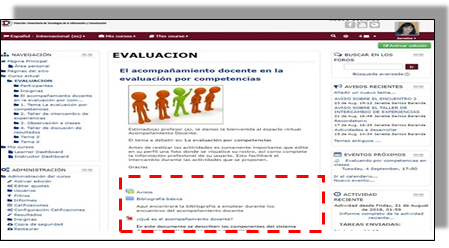
Fig. 2 Thematic conference or talk Presentation of the didactic line. Support system on the platform of the University Directorate of Information Technology and Communication (DUTIC)
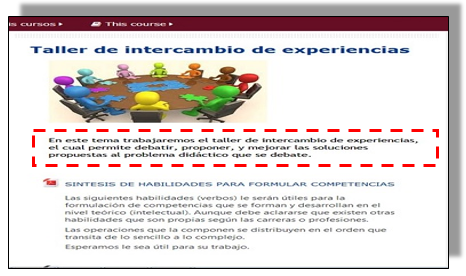
Fig. 3 Workshop for the exchange of experiences Exchanges on educational experiences and proposals for solutions to teaching problems. Support system on the platform of the University Directorate of Information and Communication Technologies (DUTIC)
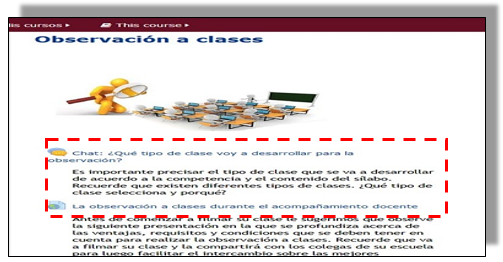
Fig. 4 Observation to classes Exchanges, filming and editing of classes using teaching guides, chat and applications. Support system on the platform of the University Directorate of Information and Communication Technologies (DUTIC)
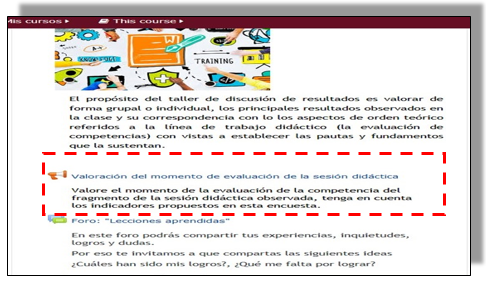
Fig. 5 Workshop to discuss results. Assessment of the results of the classes observed and lessons learned about good practices. Support system on the platform of the University Directorate of Information and Communication Technologies (DUTIC)
The video tutorials made jointly with the TVUNSA team precisely oriented the contents to work during the accompaniment. The scripts were prepared, according to the objectives of each of the activities of the accompaniment system and four videos were published on the subject, structured as follows:
Evaluation by competences
How to make rubrics?
Particularities of the evaluation in different types of classes
Evaluation in different types of classes.
For this, it was necessary to prepare the TV teachers and the TVUNSA team, taking into account that these videos fulfill a guiding didactic function in the teaching support system.
In the fourth video, fragments of the best classes made by the teachers participating in the teaching accompaniment were published to exemplify the good practices in terms of the evaluation by competences, taking into account the different types of classes. In total, 32 classes of the 34 teachers who participated in the teaching accompaniment were filmed.
The results of the applied survey appear in table 1.
Table 1 Results of the survey applied for the assessment of the assessment tool by competences (didactic line worked during the teaching accompaniment at UNSA, 2018)
| Questionnaire | Cells | |||||
|---|---|---|---|---|---|---|
| 3 | 2 | 1 | ||||
| Fa | fr | Fa | fr | Fa | fr | |
| The competencies declared in the syllabus correspond to those stated in the career profile | 17 | 68,0 | 6 | 24,0 | 2 | 8,0 |
| 18 | 72,0 | 7 | 28,0 | - | - | |
| The syllabus competences are written according to the components | 16 | 64,0 | 9 | 36,0 | - | - |
| 15 | 60,0 | 9 | 36,0 | 1 | 4,0 | |
| The performance criteria for assessing competence are stated | 17 | 68,0 | 8 | 32,0 | - | - |
| 16 | 64,0 | 9 | 36,0 | - | - | |
| The evidence that students must show and through which they can assess the competence are declared | 20 | 80,0 | 2 | 8,0 | 3 | 12,0 |
Legend: level 3: fully implemented, level 2: partially implemented, level 1: at the beginning of implementation or not implemented
Discussion
The implementation of this system, at an initial stage in person, made it possible to work on a first didactic line related to teacher planning and conception of the teaching-learning process, based on competencies.
The assessments made during the Workshop on Good Practices held at the end of the first stage by the Vice-Rector's Advisory Committee , were related to the positive willingness of teachers for change, debates and critical assessments based on the improvement of the teaching-learning process , projection towards educational research (mainly towards private didactics), the felt need to carry out a greater amount of accompanying activities and the importance of observing on- site classes for the analysis and discussion of the best experiences in the workshops. Figueroa and Gutiérrez (2013) offer similar results with the implementation of an accompaniment model for professors in the medical degree.
Despite the positive results achieved, it was found that there are still difficulties in time and space for face-to-face attendance, due to the teaching load and diversity of tasks that teachers must perform.
The second stage of virtual accompaniment allowed a greater interaction between teachers, the levels of help were customized and interaction and communication in the group were encouraged, based on the observation and analysis of the classes filmed by teachers. Likewise, the experience contributed to the socialization of good practices and to collaborative work among the participants, advantages attributed to b-learning (Morán, 2012; Marín-Díaz and Reches, 2013; Herrera, 2017; Cabero and Marín -Day, 2018).
Regarding the results of the survey applied at the end of the accompaniment from the virtual teaching-learning environment, it can be seen in Table 1, that the variable evaluation by competencies is at level two (partially implemented) with a positive trend towards level three ( fully implemented).
Some of the ideas expressed by teachers who participated in the lessons learned forum are listed below:
Improvements in the design of the rubrics corresponding to the competences formulated.
Development of ICT skills by performing activities and resource utilization of the virtual platform.
Implementation of the concept of evaluation by competencies with the completion of the designed activities.
Improvements in time management based on didactic training with the use of the virtual platform.
Satisfaction for the personalized attention they received from the interaction in the virtual platform with the coordinators of the teaching support.
The conception of the teaching support system constitutes an effective alternative for the improvement of the teaching performance of teachers, which was verified through its implementation during the years 2017 and 2018 at the National University of San Agustín de Arequipa.
The virtualization of the teacher support system in the Moodle virtual environment expanded the possibilities of teacher participation and its complementation with the face-to-face form.
The experience of the implementation of teacher support in virtual training environments reveals new potential for the integration of ICTs in the complementation of the management processes, evaluation and improvement of the teaching performance of universal teachers.
Agradecimientos
Agradecemos la colaboración y participación en este trabajo de los integrantes de la Comisión Asesora del Vicerrectorado de la Universidad de San Agustín, a la Dr. Ana María Gutiérrez Valdivia, Vicerrectora Académica, Profesora Principal. Universidad Nacional de San Agustín, Arequipa, Perú, a las profesoras Irmia Paz Torres, Betsy Cisneros Chávez, Olivia Jaen Azpilcueta, Leonor Pacheco Rodríguez, a los tele profesores Lourdes Neyra y David Rosas, así como a los directivos y equipo de trabajo de la Dirección Universitaria de Tecnologías de la Información y Comunicación (DUTIC) y de TVUNSA.
Referencias bibliográficas
Adell, J. y Castañeda, L.J. (2010). Los entornos personales de aprendizaje (PLEs): una nueva manera de entender el aprendizaje. En R. Roig, & M. Fiorucci, Claves para la investigación en innovación y calidad educativas, la integración de las tecnologías de la información y la comunicación y la interculturalidad en las aulas (págs. 19-30). España: Marfil. Recuperado el 20/04/2019, de Recuperado el 20/04/2019, de https://www.researchgate.net/publication/47721781_Los_Entornos_Personales_de_Aprendizaje_PLEs_una_nueva_manera_de_entender_el_aprendizaje [ Links ]
Bautista, G., Borges, F., y Fores, A. (2006). Didáctica universitaria en entornos virtuales de enseñanza-aprendizaje (Primera ed.). Madrid, España: Narcea, S.A. de Ediciones. Recuperado el 03/07/2018, de Recuperado el 03/07/2018, de http://www.terras.edu.ar/biblioteca/2/2BAUTISTA-Guillermo-BORGES-Federico-FORES-AnnaCAP2Ser-estudiantes-en-entornos-virtuales.pdf [ Links ]
Cabero, J. y Marín-Díaz, V. (2018). Blended learning y realidad aumentada: experiencias del diseño docente. Revista Iberoamericana de Educación a Distancia, 21(1), 57-74. doi: http://dx.doi.org/10.5944/ried.21.1.18719. Recuperado el 28/03/2019, de Recuperado el 28/03/2019, de http://revistas.uned.es/index.php/ried/article/view/18719 [ Links ]
Cabero, J., et al. (2014). Manual para el desarrollo de la formación virtual. Santo Domingo, República Dominicana: INTEC. Recuperado el 03/07/2018, de Recuperado el 03/07/2018, de https://www.researchgate.net/profile/Julio_Almenara/publication/263730640_Materiales_formativos_multimedia_en_la_red_Guia_practica_para_su_diseno/ links/5916c40ba6fdcc963e83f473/Materiales-formativos-multimedia-en-la-red-Guia-practica-para-su-diseno.pdf [ Links ]
Cabero, J. y Gisbert, M. (2005). La formación en internet. Guía para el diseño de materiales didácticos. Sevilla: Eduforma. P.109. [ Links ]
Figueroa, C. y Gutiérrez, S. (2013). Aplicación de un modelo de acompañamiento docente para la instalación e implementación curricular (MADIIC) Facultad de Medicina de la Universidad de Chile. Revista Hospital Clínico Universidad de Chile (25), 34-39. Recuperado el 28/03/2019, de Recuperado el 28/03/2019, de https://www.redclinica.cl/Portals/0/Users/014/14/14/803.pdf [ Links ]
García, L. (2018). Blended learning y la convergencia entre la educación presencial y a distancia. (L. García Areito, Ed.) Revista Iberoamericana de Educación a Distancia , 21(1), 16. doi: http://dx.doi.org/10.5944/ried.21.1.19683. Recuperado el 28/03/2019, de Recuperado el 28/03/2019, de http://revistas.uned.es/index.php/ried/article/view/19683/16899 [ Links ]
Herrera, L. (2017). Impact of Implementing a Virtual Learning Environment (VLE) in the EFL Classroom. Íkala, Revista de Lenguaje y Cultura, 22(3). doi: http://dx.doi.org/10.17533/udea.ikala.v22n03a07. Recuperado el 28/03/2019, de Recuperado el 28/03/2019, de http://www.scielo.org.co/scielo.php?script=sci_abstract&pid=S0123-34322017000300479 [ Links ]
Marín-Díaz, V., Reche, E. y Maldonado, G. (2013). Ventajas e inconvenientes de la formación online. Revista Digital de Investigación en Docencia Universitaria (1). Recuperado el 10/10/2017, de Recuperado el 10/10/2017, de https://repositorioacademico.upc.edu.pe/bitstream/handle/10757/325074/ventajasinconvenientes.pdf?sequence=1&isAllowed=y [ Links ]
Ministerio de Educación del Perú (2014). Ley Universitaria 32220. Lima: Ministerio de Educación. Recuperado el 11/10/2017, de Recuperado el 11/10/2017, de http://www.minedu.gob.pe/reforma-universitaria/pdf/ley_universitaria.pdf [ Links ]
Mishra, M., y Koehler, H. (2006). Technological Pedagogical Content Knowledge: A Framework for Teacher Knowledge. Teachers College Record, 108(6), 1017-1054. Recuperado el 20/09/2017, de Recuperado el 20/09/2017, de http://one2oneheights.pbworks.com/f/MISHRA_PUNYA.pdf [ Links ]
Morán, L. (2012). Blended learning: desafío y oportunidad para la educación actual. Revista Electrónica de Tecnología Educativa (39), 5. doi: https://doi.org/10.21556/edutec.2012.39.371. Recuperado el 10/10/2017, de Recuperado el 10/10/2017, de http://www.edutec.es/revista/index.php/edutec-e/article/view/371 [ Links ]
Roig, R., Mengual, A., y Rodríguez, C. (2013). Internet como medio de información, comunicación y aprendizaje. En J. Barroso Osuna, & J. Cabero Almenara, Nuevos escenarios digitales. Las tecnologías de la información y la comunicación aplicadas a la formación y desarrollo curricular (págs. 209-234). Madrid, España: Pirámide. Recuperado el 20/09/2017, de Recuperado el 20/09/2017, de https://dialnet.unirioja.es/servlet/articulo?codigo=6014353 [ Links ]
Santos; J. (2018). La sociedad del conocimiento, investigación, innovación y la formación permanente del profesorado. Memorias del IV Congreso de Ciencias Pedagógicas del Ecuador. La formación y superación del docente: desafíos para el cambio de la educación en el siglo XXI, 7. Guayaquil, Ecuador: Instituto Superior Tecnológico Bolivariano de Tecnología. Recuperado el 15/05/2018, de Recuperado el 15/05/2018, de https://www.pedagogia.edu.ec/ [ Links ]
Santos, J., y Armas, C.B. (2017). Sistema de acompañamiento docente para la implementación curricular en el contexto agustino. Su aplicación en las sesiones didácticas. En: La transformación curricular en la UNSA: un enfoque basado en la formación por competencias. Comisión Académica del Vicerrectorado: Arequipa, Perú. (págs. 56-61). [ Links ]
Universidad Nacional de San Agustín de Arequipa. (2016). Modelo Educativo. 1-32. Perú: Universidad Nacional de San Agustín de Arequipa. Recuperado el 15/12/2016, de Recuperado el 15/12/2016, de http://www.unsa.edu.pe/wp-content/uploads/2017/10/modelo-educativo-unsa-nuevo-2.pdf [ Links ]
Received: July 04, 2019; Accepted: December 20, 2019











 texto en
texto en 

